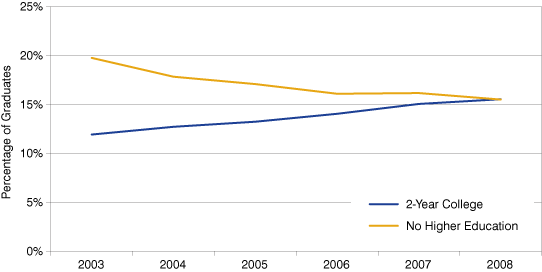The Higher Education Plans of Indiana's High School Graduates
Figure 1: Graduate Intent in Indiana High Schools, 2008

Source: IBRC, using Indiana Department of Education data
Three-quarters of Indiana high school graduates were college bound in 2008 with 60 percent of graduates saying they were headed to a four-year school and 15 percent going to a two-year college (see Figure 1). That leaves 7 percent heading to a vocational-technical school, 3 percent joining the military and 15 percent with no higher education plans.
These data come from the Indiana Department of Education (IDOE), which collects data from high schools on the next steps of their graduates.1
Table 1 shows the number of students in each category along with the change since 2003.
Table 1: Changes in Graduate Higher Education Intent, 2003 to 2008
| Higher Education Intent | Number, 2008 | Numeric Change, 2003-2008 | Percent of Total, 2008 | Percentage Point Change, 2003-2008 |
|---|---|---|---|---|
| Total Graduates | 67,250 | 6,974 | 100% | 0.0 |
| 4-Year College | 40,095 | 5,053 | 60% | 1.5 |
| 2-Year College | 10,440 | 3,260 | 16% | 3.6 |
| No Higher Education Plans | 10,417 | -1,481 | 15% | -4.2 |
| Vocational/Technical School | 4,571 | 319 | 7% | -0.3 |
| Military | 1,727 | -177 | 3% | -0.6 |
Source: IBRC, using Indiana Department of Education data
These percentages have been quite stable in recent years with two exceptions. Figure 2 shows that the percentage of graduates seeking no further education declined from 20 percent in 2003 to 15 percent in 2008. Meanwhile, the percentage choosing a two-year school has increased from 12 percent to 16 percent.
Figure 2: Trend in Two-Year College vs. No Higher Education, 2003 to 2008

Source: IBRC, using Indiana Department of Education data
Indeed, Indiana’s community college system saw rapid expansion over the last decade, with Ivy Tech Community College surpassing Indiana University’s system-wide enrollment to become the state’s largest post-secondary institution.2 However, given that the percentage of high school graduates choosing a four-year school has not declined, these data suggest that community colleges are not drawing high school graduates away from four-year institutions due to lower costs or increased credit transfer options, but are likely appealing to students who would not otherwise pursue higher education.
More high school graduates pursuing further education is considered beneficial for the person and the economy.3 Of course, higher education intent is just one step toward the goal of a more educated workforce since degree completion is also a factor in the ultimate realization of formal education’s benefits.4 Nevertheless, it is a step in the right direction.
Notes
- Schools submit a graduate report for students who receive one of eight diploma or document types. Two of these document types (certificates of achievement and course completion) are not considered diplomas. An astute data user might note that the college-bound percentage reported in this article varies slightly from the percent of graduates pursuing college education data reported on the IDOE website. This is because IDOE excludes those who received the two non-diploma documents from the denominator on that data set. However, since this article focuses on all types of higher education intent, nothing was excluded from the denominator so that the percentages would not exceed 100. Data used in this article were downloaded from the grads school building table at www.doe.in.gov/accountability/graduation-rate.
- “Ivy Tech Now Largest College System in Indiana,” Inside Indiana Business, December 10, 2008.
- Much has been written about the economic value of a degree, including “The Big Payoff: Educational Attainment and Synthetic Estimates of Work-Life Earnings” issued in July 2002 by the Census Bureau: www.census.gov/library/publications/2002/demo/p23-210.html.
- That is why one of the goals of the Indiana Commission for Higher Education’s Reaching Higher Initiative is increasing community college degree completion. Their dashboard of key indicators (updated February 2010) indicates marginal improvement on that measure, with 496 more degrees/certificates earned in 2009 compared to 2007.
Rachel Justis
Geodemographic Analyst, Indiana Business Research Center, Indiana University Kelley School of Business
